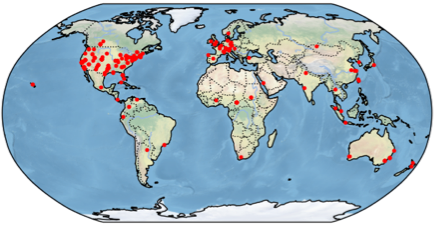
The 2020 Distributed Acoustic Sensing (DAS) Virtual Workshop and Tutorial was held August 10, 12, and 17, 2020. Sessions included varied talk formats and topics related to collecting and using DAS data aimed at a broad audience, from new users to experienced researchers. The tutorial provided an opportunity to get hands-on experience with real DAS datasets and synchronous presentations were complemented by asynchronous exercises. A Slack forum was provided to encourage energetic discussions througout the workshop and assist participants in networking. Recordings of the workshop and tutorial are now available on YouTube.
Please take a moment to review our Code of Conduct.
Key Dates:
Organizers:
For more information on the DAS Research Coordination Network, please go to the DAS RCN website. If you are interested in future DAS events or opportunities, please subscribe to the DAS RCN mailing list. If you have questions and would like to get in touch with the organizers, please email das-workshop@iris.edu.
We appreciated your participation and welcomed attendees from across six continents!

Recordings of the workshop and tutorial are now available on YouTube.
We invite you to join and explore the Slack workspace where we shared and communicated during the Workshop. If you have not yet joined the Slack workspace, use this link for access. If you are new to Slack, create a quick profile with the link above, and check out these short videos to get started:
The DAS guides listed below facilitated discussions and answered your questions during the workshop. These emerging leaders in the DAS community are fantastic resources, so check out their work, and start a conversation in your Slack channel of interest.
On Day 1 we used this Google Doc for assembling Frequently Asked Questions on DAS, then on Day 3 we divided into breakout groups and worked on answering those questions.
2020 Distributed Acoustic Sensing (DAS) Workshop and TutorialAugust 10th – 17th, 2020 at Virtual |
|
|---|---|
|
12:00 pm |
August 10th, 2020 Day 1 Agenda - All times Eastern U.S., led by Scott Tyler and Dante Fratta This workshop was held via Zoom webinar, with sign-in information emailed directly to participants to ensure security. The session has been recorded and is available on YouTube.
In preparation for the workshop, here are some background subject materials:
You can view the recordings for Day 1 of the 2020 DAS Workshop here (videos were captioned by automatic processing and may have ample mistakes):
|
|
12:00 pm |
August 12th, 2020
Here is how to open the Jupyter Notebooks on Day 2 to analyze some real DAS data:
Here are some introductory resources on Jupyter Notebooks and Python: You can view the recordings for Day 2 of the 2020 DAS Workshop here (videos were captioned by automatic processing and may have ample mistakes):
|
|
12:00 pm |
August 17th, 2020
You can view the recordings for Day 3 of the 2020 DAS Workshop here (videos were captioned by automatic processing and may have ample mistakes):
|